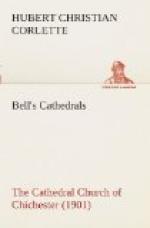About 1749 the Duke of Richmond’s vault was “diged and made” [23] in the lady-chapel, and ten years later “the kings and bishops in the cathedral” were “new painted.” The floor of the lady-chapel was raised to give height to the vault beneath, and a fireplace and chimney built up in front of the east window. Portions of the other windows were plastered up, and so left only partly filled with glass. These served to provide light in what was now to be the library, since, apparently, the originally well-lighted library, above the chamber now used for the purpose, had lost its proper roof and been otherwise made useless.
[23] Spershott.
There is little else to be said concerning the history of the building during eighteenth century; but it is stated by a careful observer, [24] writing in 1803, that “in the interior of this cathedral few innovations have been effected.” He says that the east window of the lady-chapel is plastered up, and that
“we find that the great window in the west front of the cathedral has a short time back had its mullions and other works knocked out, and your common masoned ‘muntings’ (mullions) and transoms stuck up in their room, without any tracery sweeps or turns, of the second and third degrees; which work may before long be construed by some shallow dabblers in architectural matters into the classical and chaste productions of our old workmen. On the north and south sides of the church are buttresses, with rare and uncommon octangular-columned terminations; but they have likewise, to save a trifling expense in reparation, been deprived of their principal embellishments, and are now capped with vulgar house-coping....
“It may be well
to speak of the west porch as an excellent
performance; and the
statue over the double entrance is
remarkably so.”
[24] Gentleman’s Magazine, Part I., 1803, pp. 22-25.
Proceeding, the same writer relates that:
“Against the east and west walls of the said transept are affixed historic paintings; those on the west side (the figures as large as life) relate to the founding of the church and its re-edification in Henry viii.’s time. Among the various portraits is that of Henry viii. himself. Here are also in separate circular compartments, the quarter portraits of our kings, from William the Conqueror to Hen. viii. (and since his day, in continuation to George i.) On the east side is the entire collection of the ancient bishops of the see (quarter lengths, and in circular compartments). A short time back the faces of the several portraits were touched upon by some unskilful hand; however we have before us most curious specimens of the costume of Henry’s day, when the whole of these paintings were done (excepting those of subsequent dates), in dresses, warlike habiliments, buildings, etc....
“Looking towards the north, on




